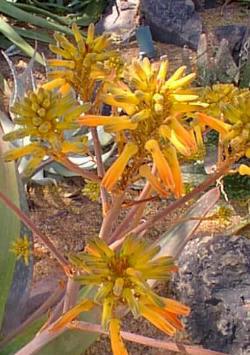Aloe buhrii |
Asphodelaceae
Lavranos
|
Aloe buhrii was nsmed after Elias Buhr who was the first collector.
Aloe buhrii is similar to Aloe striata, a few characteritics can help identify the two. Aloe buhrii has narrower and more upright leaves that are yellowish-green in colour leaves that are thicker than Aloe striata. The inflorescences are also divided into multiple racemes. |
| Common Names: |
- |
| Status: |
Rare, due to a small population. |
| Distribution: |
Aloe buhrii has a small ditribution area that is near Calvinia in the Northern Cape. |
| Description of Aloe buhrii: |
| Stem: |
Aloe buhrii is stemles and old specimens will form multiple large low growing heads. |
| Leaves: |
The leaves (400 mm) are smooth and striated with thinner lines parallel to the axis of he leaf. As the leaves mature they turn purplish with white spots and the lines disappear. The leaves have a broad red margin. The leaf margin may be smooth to finely toothed. |
Flower Description: |
| Inflorescence: |
Inflorescence is complex and forms up to fifteen racemes that are head-shaped. |
| Flower: |
Flowers are orange-red and very rarely yellow in colour, buds point upwards and upon flowering they hang down. |
| Flowering Time: |
Flowering occurs from August to October. |
Cultivation of Aloe buhrii: |
| Light: |
Light-shade to Full sun. |
| Watering: |
Aloe buhrii is drought resistent, Careful watering required. |
| Frost Protection: |
Frost protection required. |
| Notes: |
Aloe buhrii is difficult to cultivate as it prefers a winter rainfall, in summer rainfall areas it is prone to black and rusty leaf spots. |
Picture: Aloe buhrii in cultivation.

Picture: Aloe buhrii in flower.

Photographer: Phillipe Faucon of Phoenix Tropical Gardens
|